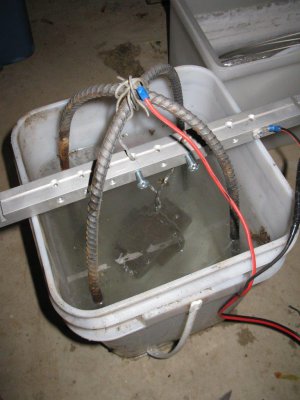- Joined
- Sep 28, 2013
- Messages
- 4,318
Hi all,
I just set up a tub for electrolytic derusting, using some rebar, a constant current power supply and some sodium carbonate (washing soda). +ve to the rebar, -ve to the thing to be derusted

The question is - how good a result should I expect and how long will it take? The chuck in there wasn't hugely rusty and it went from that to mostly not rusty in a couple of hours (7V and 1.2A), but isn't completely clean of rust after being left running overnight. I've also stuck a cross slide cover and a toolholder in there (one on either side of the chuck) and left those overnight at 3 - 4V and 2A, but they don't look any different.
Did they volts drop because I have more items in the bath?
There are plenty of bubbles coming up from the items (lots at 1.2A and a storm of them at 2A) and slightly fewer coming from the rebar. Are bubbles supposed to come up from the rebar?
Should the items be completely free of rust or should I expect some wire wheel work to remove the last of it?
Any other suggestions?

I just set up a tub for electrolytic derusting, using some rebar, a constant current power supply and some sodium carbonate (washing soda). +ve to the rebar, -ve to the thing to be derusted

The question is - how good a result should I expect and how long will it take? The chuck in there wasn't hugely rusty and it went from that to mostly not rusty in a couple of hours (7V and 1.2A), but isn't completely clean of rust after being left running overnight. I've also stuck a cross slide cover and a toolholder in there (one on either side of the chuck) and left those overnight at 3 - 4V and 2A, but they don't look any different.
Did they volts drop because I have more items in the bath?
There are plenty of bubbles coming up from the items (lots at 1.2A and a storm of them at 2A) and slightly fewer coming from the rebar. Are bubbles supposed to come up from the rebar?
Should the items be completely free of rust or should I expect some wire wheel work to remove the last of it?
Any other suggestions?


